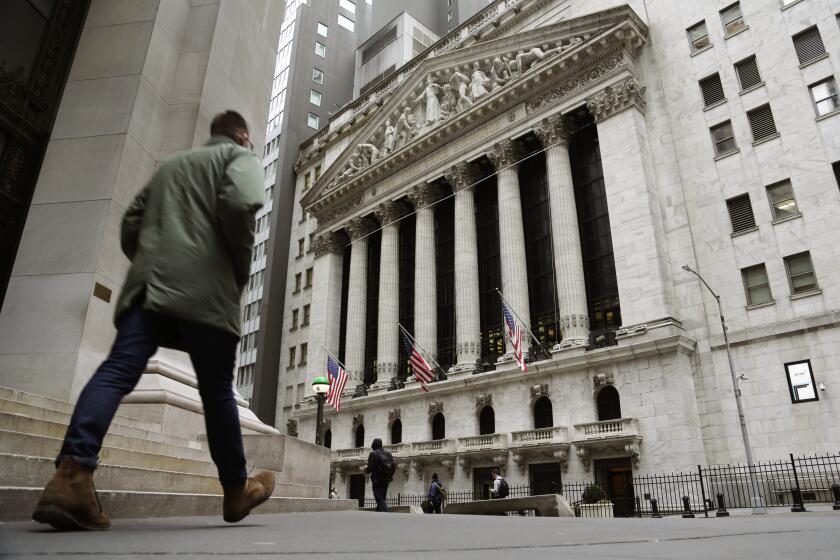Hopes for a Slowdown Are Re-Energizing Stocks, Bonds
- Share via
Sometimes it doesn’t matter what Wall Street knows--it just matters what Wall Street wants to believe.
And what stock and bond markets fervently want to believe right now is that the U.S. economy is slowing and that interest rates have peaked. Any evidence to the contrary need not bother to compete for investors’ attention.
That became obvious last Friday when, in a surprise, the government reported that the nation’s unemployment rate actually rose in January, to 5.7% from 5.4% in December. The news sparked a buying frenzy in stocks and bonds, sending the Dow Jones industrials soaring 57.87 points to 3,928.64 and the 30-year U.S. Treasury bond yield plummeting to a five-month low of 7.62% from 7.74% Thursday.
The markets’ rally ignored economists’ warnings that the January employment report wasn’t quite what it seemed. Job losses in key states during the month were largely weather-related and temporary, many experts argued. Two important sectors of the economy--construction and manufacturing--continued to create jobs, and the overall average weekly wage jumped 1.5% from December as total hours worked increased.
Moreover, car sales in January continued at a brisk pace, down only slightly from a year ago. And despite the conventional wisdom that the housing market is falling off a cliff because of higher interest rates, the Mortgage Bankers Assn. says mortgage applications from would-be home buyers surged in January.
“I think it’s premature to say we’ve got a slowing economy,” said David Lereah, economist for the mortgage bankers’ group in Washington, D.C.
But that has been the wrong investment thesis since November:
* The bond market in particular has been acting as if a slowdown is a done deal. The 30-year T-bond yield, a benchmark for long-term interest rates, has been ratcheting lower since peaking at a 3-year high of 8.16% in mid-November.
Shorter-term yields also have tumbled. Investors who buy 3-year Treasury notes at the government’s auction of those securities on Tuesday, for example, will have to settle for an annualized yield of around 7.3%. In mid-December 3-year T-notes paid 7.7%.
* In the stock market, issues that are especially sensitive to interest rate trends also have been rallying. The Dow Jones utility-stock index, for example, has risen 12% since mid-November, in effect confirming that investors believe the downtrend in long-term bond yields is for real.
Some utility stocks’ gains have been spectacular. Shares of SCEcorp., parent of Southern California Edison, closed at $16.50 on Friday, up 33% from their low price last fall of $12.375.
* In the broad market, classic growth stocks like Gillette and Sara Lee--whose earnings tend to rise at a predictable pace in any type of economy--have been hitting new highs over the past month. Meanwhile, stocks of auto companies, steel makers and other heavy-industry firms whose earnings depend on a vibrant economy have been sinking.
Because financial markets’ primary job is to anticipate the future, some investment pros argue that it’s time for the economy bulls to accept the markets’ verdict and stop fighting the idea of slower growth.
It’s worth noting that the Dow utility index was a frighteningly accurate--and early--predictor of interest rates’ surge in 1994. The index peaked in September, 1993, and by the end of that year had lost 11% of its value, long before the broad market manifested any hint of concern about prospects for higher interest rates.
John R. Williams, economist at Bankers Trust in New York, contends that recent economic data and financial market action “seem consistent with gross domestic product growth slowing to a pace of 2.5% to 3% in the first quarter and to a bit below 2.5% by around mid-year,” down from a torrid 4.5% annualized rate in the fourth quarter.
Though the January employment report may have been inconclusive, other reports have hinted at a weaker tone to the economy over the last few months. Business inventories are rising, and orders for non-defense capital goods other than aircraft eased in both November and December. What’s more, Mexico’s financial crisis is expected to slash what had been tremendous demand for U.S. exports in the near term.
A slowdown in the U.S. economy would in theory keep inflation contained, allow the Federal Reserve Board to stop raising short-term interest rates (after seven increases over the past 12 months) and potentially set the stage for a more stretched-out economic expansion--avoiding the usual recessionary bust that follows heated growth.
The only disturbing element of this “soft landing” scenario is its timing: Most economists had expected a strong economy to carry into the first half of 1995, to be followed by a slowdown in the second half.
Likewise, bond yields had been expected to continue rising in the first half of this year, and the stock market, accordingly, was thought to be primed for a plunge.
Chalk up another defeat for Wall Street groupthink. “Markets are perverse,” shrugs James Engle, chief investment officer at Wood, Struthers & Winthrop in New York. “Once everybody adjusts to one condition, the market goes the other way.”
Some analysts say expectations that last year’s strong economic growth would automatically spill into the first half of this year ignored the reality of normal ebbs and flows in consumer spending and business activity, even during expansions.
From quarter to quarter, “speed-ups and slowdowns are how the economy goes along,” said Henry Gailliot, economist at Federated Investors in Pittsburgh. Strong growth late in 1992, for example, was followed by a slowdown early in 1993--even though interest rates were falling.
Yet Gailliot doesn’t view the current slowdown as the early stage of a true soft landing. Instead, he expects a temporary lull in the economy, then faster growth later this year--in other words, the reverse of the cycle Wall Street had been expecting in ’95.
Still working in the global economy’s favor, after all, are Europe’s accelerating recovery, healthy growth in most developing nations (excluding Mexico) and an expected lift in Japan from massive spending to rebuild the earthquake-devastated city of Kobe.
All of this means the Fed probably isn’t finished raising short-term interest rates, Gailliot said. Which means that long-term bond yields also should rebound later this year, he warns. “This (slowdown) simply represents a pause in the rise of interest rates,” he said.
For now, however, stock and bond markets aren’t looking that far ahead. After finally getting what they want--some tepid economic numbers--the markets seem intent on rallying, and anyone standing in their way just risks being bowled over.
More to Read
Inside the business of entertainment
The Wide Shot brings you news, analysis and insights on everything from streaming wars to production — and what it all means for the future.
You may occasionally receive promotional content from the Los Angeles Times.










